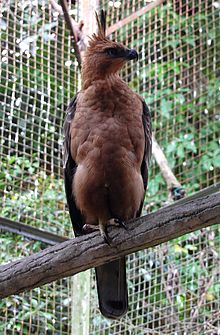Javan hawk-eagle
| Javan hawk-eagle | |
|---|---|
 |
|
| Javan hawk-eagle, Ragunan Zoo, Jakarta | |
| Scientific classification | |
| Kingdom: | Animalia |
| Phylum: | Chordata |
| Class: | Aves |
| Order: | Accipitriformes |
| Family: | Accipitridae |
| Genus: | Nisaetus |
| Species: | N. bartelsi |
| Binomial name | |
|
Nisaetus bartelsi Stresemann, 1924 |
|
| Synonyms | |
|
Spizaetus bartelsi |
|
Spizaetus bartelsi
The Javan hawk-eagle (Nisaetus bartelsi) (earlier placed in Spizaetus) is a medium-sized, approximately 60 cm long, dark brown raptor in the family Accipitridae. Its head and neck are rufous and it is heavily barred black below. This majestic and intricately patterned eagle has a long, black crest on its head; this crest is held almost vertically and is tipped with white. The crown is black, topping a chestnut head and nape. The back and wings are dark brown, fading to a lighter brown tail which has wide cream stripes. The throat is creamy white with a black stripe, running to the whitish breast and underparts, which are heavily barred with chestnut. Juvenile birds are similar in colour, but have plainer underparts and a duller head. The sexes are similar.
An Indonesian endemic, the Javan hawk-eagle occurs in humid tropical forests of Java. Its range in East Java includes Sempu Island, Bromo Tengger Semeru National Park, Meru Betiri National Park and Alas Purwo National Park. It can also be seen in captivity in zoos like Kebun Binatang Bandung
The Javan hawk-eagle is believed to be monogamous. The female usually lays one egg in a nest high on top of a forest tree. The diet consists mainly of birds, lizards, fruit bats and mammals.
The Javan hawk-eagle is the national bird of Indonesia, where it is commonly referred to as Garuda, from the bird-like creatures in Hindu and Buddhist myths. The scientific name commemorates the Bartels family, who discovered it.
Because of the plumage variability of Spizaetus eagles, the Javan hawk-eagle was not recognised as a full species until 1953.
It is one of the rarest raptors. Due to ongoing habitat loss, small population size, limited range and hunting in some areas, it is evaluated as Endangered on the IUCN Red List of Threatened Species. It is listed on Appendix II of CITES.
...
Wikipedia

